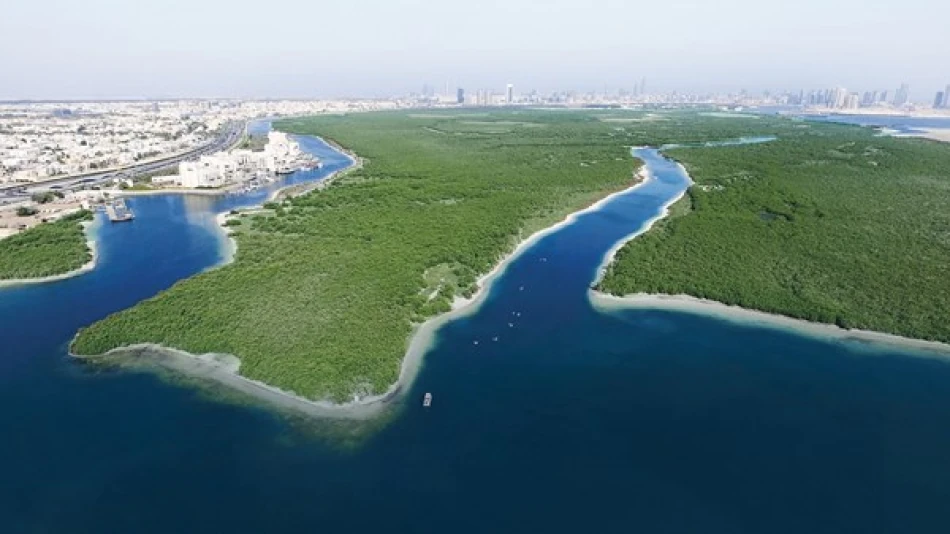
UAE Leads Mangrove Conservation Efforts on World Mangrove Day
UAE Emerges as Global Mangrove Conservation Leader with Ambitious 100 Million Tree Initiative
The United Arab Emirates has positioned itself as a regional powerhouse in coastal ecosystem restoration, leveraging mangrove forests as a natural defense against climate change while pursuing an unprecedented goal of planting 100 million mangrove trees by 2030. This ambitious environmental strategy, coinciding with World Mangrove Ecosystem Conservation Day on July 26, demonstrates how oil-rich nations can pivot toward nature-based climate solutions.
A Climate Strategy Rooted in Natural Solutions
The UAE's mangrove initiative represents more than environmental symbolism—it's a calculated investment in climate resilience. With over 30 million mangrove trees already planted by mid-2025, the Emirates has achieved nearly one-third of its target using cutting-edge methods including drone seeding and tissue cultivation techniques.
Dr. Amna bint Abdullah Al Dahak, Minister of Climate Change and Environment, emphasized the strategic importance of these coastal guardians, noting their carbon sequestration capacity is four times greater than tropical rainforests. This efficiency makes mangroves particularly valuable for nations pursuing aggressive decarbonization timelines, as the UAE aims for climate neutrality by 2050.
Technology Meets Conservation
The Emirates has distinguished itself through innovative planting methodologies that could serve as blueprints for other coastal nations. The drone-based seeding program utilizes artificial intelligence to identify optimal planting sites and distribute seeds with precision, dramatically accelerating restoration timelines compared to traditional manual planting.
The "Mangrove Propagation" program focuses on biotechnology-enhanced seedling cultivation, producing hardy specimens capable of thriving in diverse coastal environments. This technological approach addresses a common challenge in mangrove restoration: ensuring high survival rates in harsh saltwater conditions.
Global Ambitions Beyond National Borders
The UAE's mangrove strategy extends far beyond its own coastlines through the Mangrove Alliance for Climate, which unites 45 governments and NGOs in coordinated conservation efforts. This multilateral approach reflects growing recognition that coastal ecosystem protection requires international cooperation, similar to how Singapore and Indonesia have collaborated on regional marine conservation.
Strategic Partnerships and Research Hubs
The Mohammed bin Zayed-Joko Widodo Mangrove Research Center in Bali represents the UAE's commitment to science-based conservation. By establishing research infrastructure in Indonesia—home to the world's largest mangrove forests—the Emirates gains access to diverse ecosystems while contributing expertise in restoration technology.
The upcoming IUCN World Conservation Congress in Abu Dhabi this October will feature mangrove conservation as a central theme, positioning the UAE as a thought leader in nature-based climate solutions.
Economic Logic Behind Environmental Leadership
For investors and policymakers, the UAE's mangrove focus offers insights into how resource-rich nations can diversify their environmental portfolios. Mangroves provide measurable returns through coastal protection, carbon credits, and marine biodiversity enhancement—creating economic value alongside environmental benefits.
This approach mirrors broader Gulf state strategies of investing oil revenues in sustainable infrastructure, though the UAE's emphasis on exportable conservation technology could generate new revenue streams in environmental services.
Regional Competition and Collaboration
The Emirates' mangrove leadership occurs within a competitive regional context where Gulf states increasingly vie for environmental credibility. While Saudi Arabia focuses on massive reforestation projects and Qatar emphasizes renewable energy, the UAE has carved out coastal restoration as its signature climate initiative.
This specialization allows for regional collaboration rather than duplication, with each nation developing expertise in complementary areas of climate action.
Measuring Success in a Changing Climate
The UAE's progress toward its 100 million tree target will serve as a crucial test case for large-scale ecosystem restoration. Success depends not merely on planting numbers but on long-term survival rates, ecosystem integration, and measurable climate benefits.
Early indicators suggest strong momentum, with the 30 million trees planted by mid-2025 representing significant progress toward the 2030 goal. However, the true measure of success will be the program's contribution to the UAE's broader climate neutrality objectives and its influence on global conservation practices.
As coastal nations worldwide grapple with rising sea levels and increasing storm intensity, the UAE's mangrove model offers a replicable framework for combining traditional conservation with modern technology, potentially reshaping how governments approach nature-based climate solutions.
 Layla Al Mansoori
Layla Al Mansoori







